Spotlight on Q3: The Unexpected Rebound in Employee Happiness
Q3 eNPS defies the norm; tenured employees happier than new employees
October 30, 2024
In Q3, the average eNPS climbed to 36, reflecting a 3% increase from Q2's 35, with September climbing back to the same eNPS score as March of this year. This period also coincides with a decrease in turnover, indicating that more employees are staying put, which could possibly be a reflection of happier employees.
Looking ahead, if employee happiness continues to increase in Q4, as it has in each of the last 4 years, 2024 could see some recovery from the overall downward eNPS trend of the last 3 years.
In this report, based on eNPS® data from over 60,900 employees across various industries, we’ll look at the elements driving this positive change, examining how different sectors and organizations have succeeded in boosting employee morale and satisfaction.
What’s Employee Net Promoter Score (eNPS)*?
eNPS helps employers measure employee satisfaction. It consists of a numeric rating of how likely employees are to recommend the organization as a place to work. Employees select a score from 0–10, and these scores, categorized as Promoters (9 or 10), Passives (8), and Detractors (7 or below), are used to quantify how employees feel about their company.
The eNPS score is then calculated by taking the percentage of Promoters and subtracting the percentage of Detractors. The resulting score can range from -100 to +100, with higher eNPS scores indicating a higher level of employee satisfaction and loyalty. What is a good eNPS?
- Above 0 is good.
- Above 20 is favorable.
- Above 50 is excellent.
- Above 80 is world class.
*Net Promoter, NPS, and the NPS-related emoticons are registered U.S. trademarks, and NetPromoter Score and Net Promoter System are service marks, of Bain & Company, Inc., NICE Systems, Inc. and Fred Reichheld.
Average eNPS Sees First Spike in Q3 in 3 Years
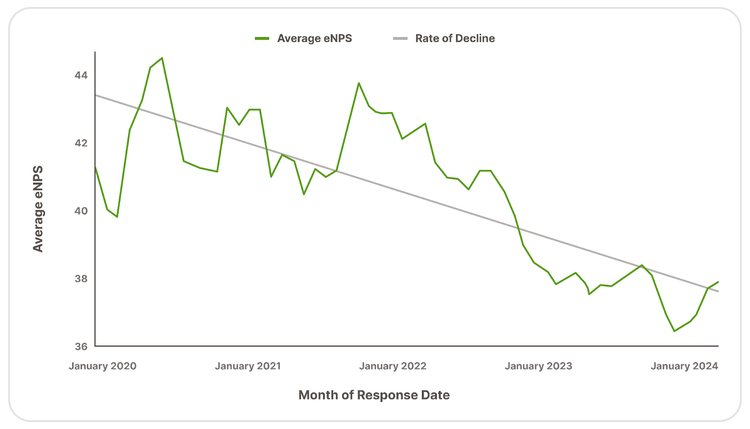

In the wake of a challenging second quarter where employee happiness reached its lowest point in four years, the third quarter of 2024 has brought an unexpected and welcome rebound in employee satisfaction.
Historically, Q3 has been a period of decrease for eNPS, but this year defies that trend, offering a glimmer of hope for organizations striving to raise workplace morale.
For HR professionals and their organizations, understanding employee satisfaction trends is critical for identifying improvement areas, developing strategies to boost employee experience, and benchmarking against industry standards. This ongoing tracking, via eNPS surveys or other means, helps assess the effectiveness of HR initiatives and make informed decisions to support a thriving work environment.
This report dives into the factors driving this positive shift. We explore how different sectors and organizations have successfully boosted employee morale and job satisfaction, providing valuable insights for HR professionals and business leaders aiming to foster a thriving work environment.
Editor’s Note: Respondent quotes were sourced from external interviews. All names and identifying information have been changed to protect privacy. Quotes have been lightly edited for clarity and concision.
"Employee happiness is more than just a metric—it's a reflection of the culture and values that organizations cultivate every day. This unexpected rebound in Q3 highlights the resilience and adaptability of teams across various industries. By focusing on meaningful engagement and genuine connection, companies can create workplaces where people feel valued and inspired to do their best work."
Anita Grantham | Head of HR | BambooHR
Employee Satisfaction Key Takeaways
Key Takeaways by Employee Group
Employee Tenure: Tenured employees are happier than newer employees for the second time in the last four years.
Company Headcount: Companies with 150+ employees saw significant eNPS increases in Q3.
Key Takeaways by Industry
Construction: Maintained highest eNPS, with marginal quarterly increases.
Travel & Hospitality: Reached a new four-year high in August.
Finance: Recorded its highest quarterly eNPS since Q4 2022.
Nonprofit: eNPS continued to fall, hitting a four-year low in Q3.
Education: Recovered from Q2, achieving a four-year high in September.
Technology: Saw its largest eNPS rebound since 2022 after a rough Q2.
Restaurant, Food & Bev: eNPS remained steady, following Q2's decline.
Healthcare: eNPS substantially rebounded to levels seen in Q3 2023.
Tenured Employees and Larger Companies Lead the Way in Q3
In the third quarter of 2024, companies with a workforce predominantly composed of tenured employees (3+ years tenure) reported a 1% higher happiness level on average compared to companies with a majority of newer employees.
While 1% isn’t much, this marks only the second time since 2020 that more tenured employees have expressed greater happiness. The first time was Q3 2023.
Regionally, North America continues to hold its position as the happiest region for workers, maintaining an average happiness score of 40 in September. Meanwhile, Europe/Middle East (EMEA) has rebounded from its Q2 slump, achieving an average score of 29, on par with Asia Pacific (APAC), which also recorded a score of 29.
In terms of company size, larger organizations—particularly those with more than 150 employees—experienced increases in eNPS during Q3. Notably, companies with over 500 employees saw the most significant improvements, indicating an unusual positive trend in employee satisfaction within larger corporate environments.
Tenured Employees 1% Happier than New Employees
For the first time since Q3 of last year, employees with longer tenures—those who have been with their companies for more than three years—are reporting higher happiness levels than their newer counterparts. Employees with more than three years of tenure are, on average, 1% happier than their colleagues with less than three years of experience at their current company. This marks a shift from previous quarters and suggests that longer tenure can also be associated with increased job satisfaction.
This shift underscores the value of investing in long-term employee engagement strategies. As employees settle into their roles and build deeper connections with their teams, they may find more fulfillment and purpose in their work. This trend also highlights the importance of recognizing and rewarding the contributions of seasoned employees, who bring invaluable institutional knowledge and stability to their organizations.
Understanding these tenure-related trends can help organizations better support both new and long-standing employees. While it's important to invest in onboarding and integrating new hires, ensuring that tenured employees continue to feel valued and engaged is equally crucial.
Employee Tenure Average eNPS 2020–2024
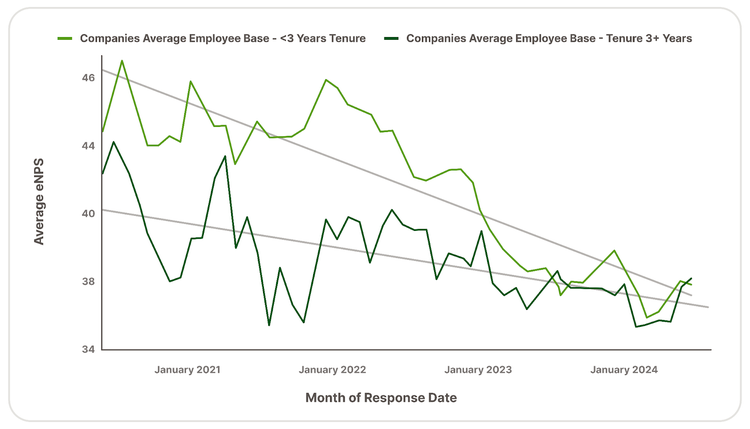

Companies with 500+ Employees See Spike
Smaller companies, particularly those with 1–24 employees, led with the highest eNPS score as they have in previous quarters, indicating a strong positive sentiment among their workforce. Companies with 25–75 employees and 76–150 employees follow behind with scores of 41 and 36, respectively.
Larger companies with 151–300 employees and 301–500 employees had lower eNPS scores of 31 and 32, respectively. However, the largest companies—those with more than 500 employees—saw a notable spike in eNPS, a 20% increase from Q2.
This significant rise among the largest companies suggests a positive shift in employee satisfaction and loyalty, highlighting that larger organizations are making strides in improving their workplace environments and employee engagement during this period.
Company Headcount Average eNPS Q3 2024
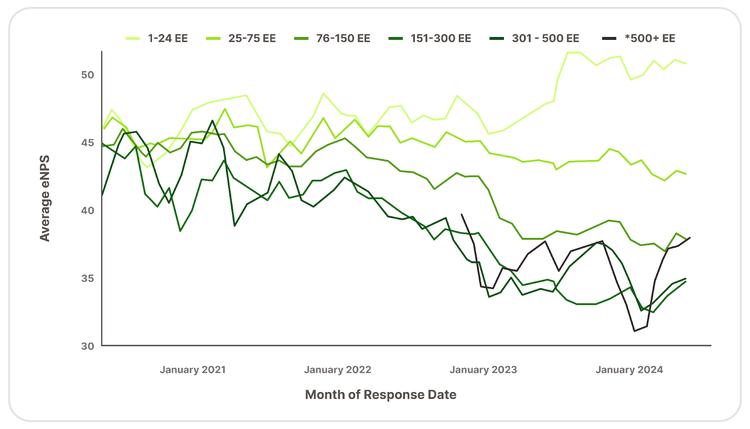
“In the ever-evolving landscape of business, it's heartening to see that larger organizations, particularly those with over 500 employees, are experiencing a small boost in employee satisfaction. This trend underscores the importance of fostering a supportive and engaging work environment, regardless of company size.
As we continue to navigate the complexities of the modern workplace, let's keep our focus on creating spaces where every team member feels valued and empowered to contribute their best."
Anita Grantham | Head of HR | BambooHR
Employee Satisfaction by Industry
All Industries See an Increase in Happiness Except Nonprofit
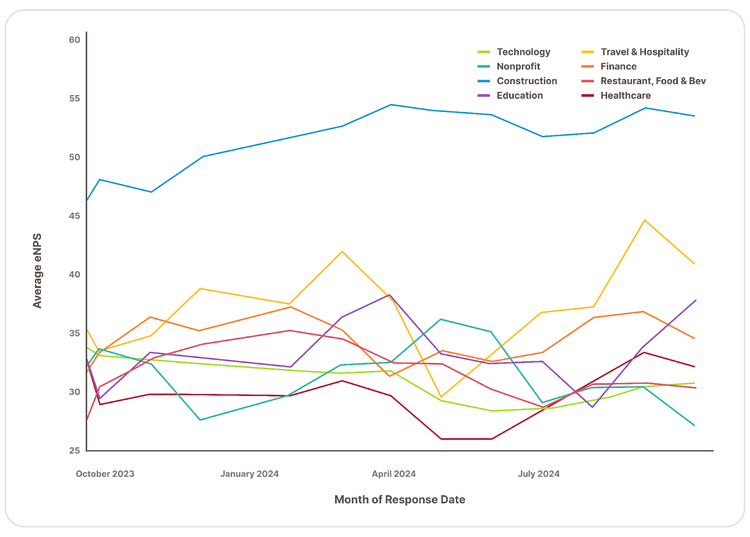
Industries Ranked from Happiest to Unhappiest
Construction
Construction Average eNPS 2023–2024
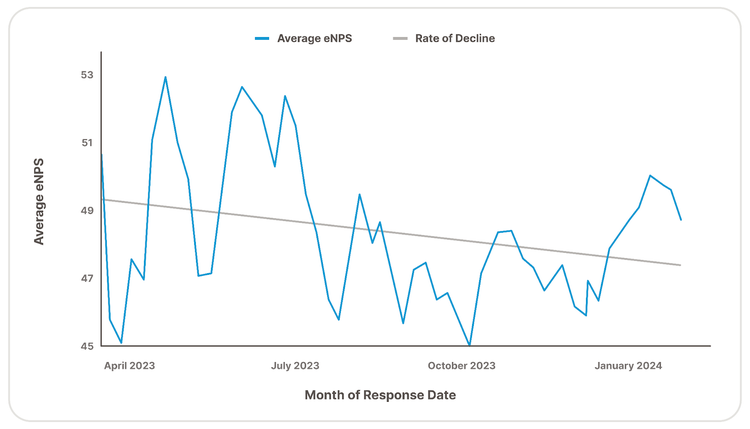
- eNPS remained consistent from Q2 to Q3, with an average of 52.
- There was a marginal increase from Q2 to Q3.
- Compared to September last year, eNPS is 6 points higher, a 13% increase.
The construction industry maintained its typical high level of employee satisfaction in Q3 2024, with an eNPS of 52, which is consistent with previous quarters. The marginal increase from Q2 to Q3, along with a 6-point rise compared to September last year, highlights the industry's steady improvement in employee happiness. This consistent performance underscores the sector's ability to sustain high levels of employee satisfaction over time.
"It's a fast-paced, revolving door with many employees leaving due to stress. It can be rewarding but sometimes not worth it, especially in summer. It's often stressful and takes me away from my family. Financially, it's pretty good, but the tradeoffs are long hours and a lot of work."
Installation Manager | Construction Company
Travel & Hospitality
Travel & Hospitality Average eNPS 2023–2024
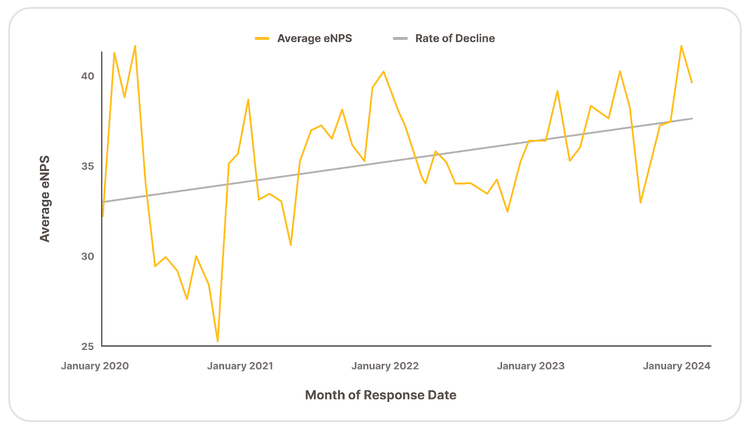
- Q3 eNPS increased by 17% from Q2, reaching a new four-year high of 42.
- eNPS is 4 points higher compared to September last year.
- August marked a four-year high with an eNPS of 45.
The travel and hospitality industry achieved a remarkable recovery in Q3 2024, with a 17% increase in eNPS from the previous quarter to reach a new four-year high. The eNPS of 42 in Q3 and the peak of 45 in August reflect significant improvements in employee satisfaction. Compared to September last year, the eNPS is 4 points higher—a 12% increase—indicating a strong upward trend in employee happiness.
“I have received more pay raises in the last couple of years, which is a big motivator. Another motivator for me has been the ability to work from home. Before COVID, I had to travel nearly one hour to reach my office, which was overwhelming and stressful, but now I can work remotely, which is great.”
Travel Consultant | Travel Agency
Finance
Finance Average eNPS 2023–2024
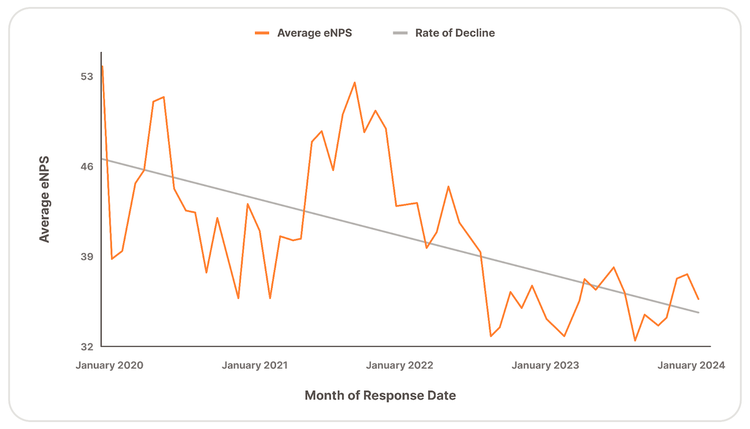
- Q3 had the highest quarterly average since Q4 2022, with an eNPS of 38.
- There was a 6% increase from Q2 to Q3.
- Compared to September last year, eNPS is 3 points higher.
The finance industry experienced a notable improvement in Q3 2024, achieving its highest quarterly eNPS average since Q4 2022. The 6% increase from Q2 to Q3 reflects growing employee satisfaction, and the eNPS is 3 points higher than in September of the previous year—a 7% increase. This upward trend suggests a strengthening of employee engagement and satisfaction within the sector.
"I've been very happy in my role. I really like financial markets and trading. It's something I thoroughly enjoy. But I would like more opportunities for growth.”
Trader | Proprietary Trading Company
Education
Education Average eNPS 2023–2024
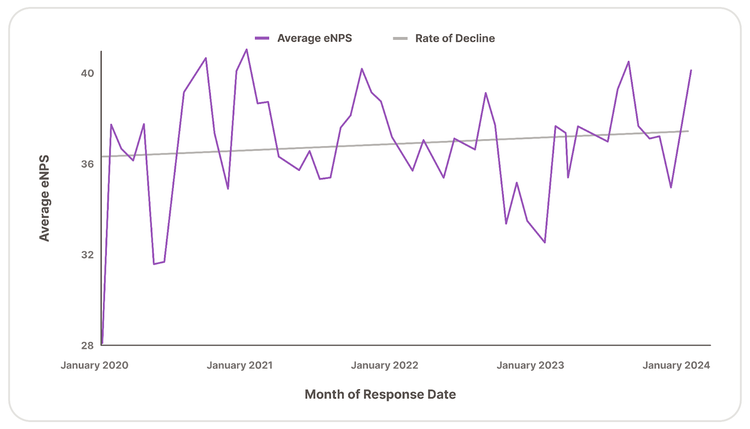
- Q3 eNPS increased to 36 from 35 in Q2.
- There was a 2% increase from Q2 to Q3.
- Compared to September last year, eNPS is 5 points higher—a 12% increase.
The education sector saw a positive shift in Q3 2024, with a 2% increase in eNPS from the previous quarter, reaching 36. This improvement marks a recovery from Q2 and a significant 5-point increase compared to September last year. The sector's ability to achieve a four-year high in September indicates a strong recovery in employee satisfaction and engagement.
"My job is a lot of work but has benefits, like how rewarding it is to teach and having breaks that align with my children's schedules. However, I often consider leaving teaching due to the mental and physical exhaustion. The days are long, and you always take your work home with you on the weekends and evenings."
Teacher | High School
Healthcare
Healthcare Average eNPS 2023–2024
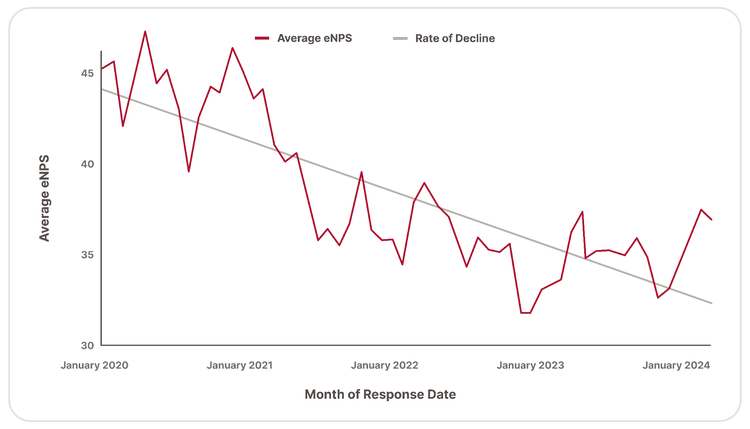
- Q3 eNPS increased by 14% from Q2, reaching an average of 35.
- eNPS is 1 point lower compared to September last year, a 1% decrease.
- The industry has recovered to a similar point seen in Q3 2023.
The healthcare industry saw a significant recovery in Q3 2024, with a 14% increase in eNPS from the previous quarter, bringing the average to 35. This recovery aligns with the levels seen in Q3 2023, indicating a positive trend after previous declines. However, when compared to September of the previous year, the eNPS is lower by 1 point, suggesting room for further improvement.
"I've been relatively happy and have a good role. The group I'm a part of is very good. What’s not going well in my industry is there are a lot of shortages, a lot of people get burned out, and it's often thankless.”
Orthopedic Surgeon | Private Practice
Restaurant, Food & Beverage
Restaurant, Food & Beverage Average eNPS 2023–2024
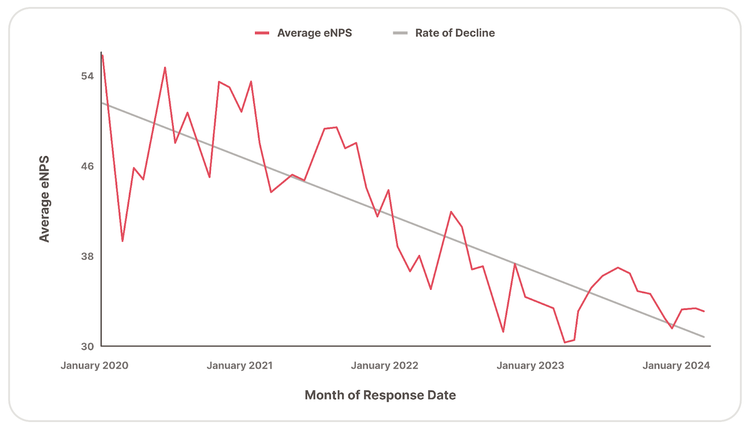
- Q3 eNPS held steady at 34, the same as Q2.
- There was a marginal increase from Q2 to Q3.
- Compared to September last year, eNPS is 3 points higher—an 8% increase.
The restaurant and food & beverage industry maintained its eNPS at 34 in Q3 2024, consistent with the previous quarter. Despite the stability, there was a marginal increase from Q2 to Q3, and the eNPS is 3 points higher now than in September of the previous year. This suggests a gradual improvement in employee satisfaction, although the industry still faces challenges in achieving more significant gains.
"There’s a lot of stability; food and beverage is going to be omnipresent no matter how advanced tech gets—people are still going to eat. I think it's a pretty resilient industry. However, compensation is not the best.”
Sales Rep | Food Manufacturing Company
Technology
Technology Average eNPS 2023–2024
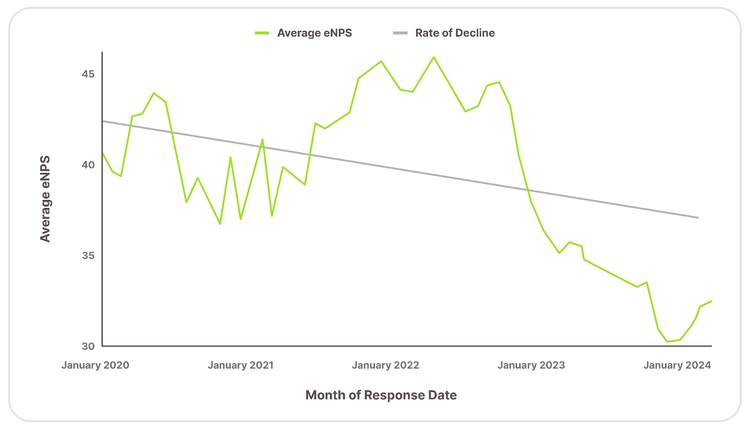
- Q3 eNPS rose by 1 point from Q2, reaching 33.
- There was a 4% increase from Q2 to Q3.
- eNPS is 2 points lower compared to September last year.
The technology industry experienced a modest recovery in Q3 2024, with a 1-point increase in eNPS from the previous quarter, reaching 33. This 4% rise marks the largest rebound since 2022, although the eNPS remains 2 points lower than in September of the previous year, a 7% decrease. The industry shows signs of recovery, but further efforts are needed to regain previous levels of employee satisfaction.
"When return-to-office mandates kicked in, happiness declined. We're pushed to deliver more results under the pretense of needing office presence for creativity and productivity, despite proving our high profitability even when fully remote."
Social Content and Engagement Strategist | Retail Industry
Nonprofit
Nonprofit Average eNPS 2023–2024
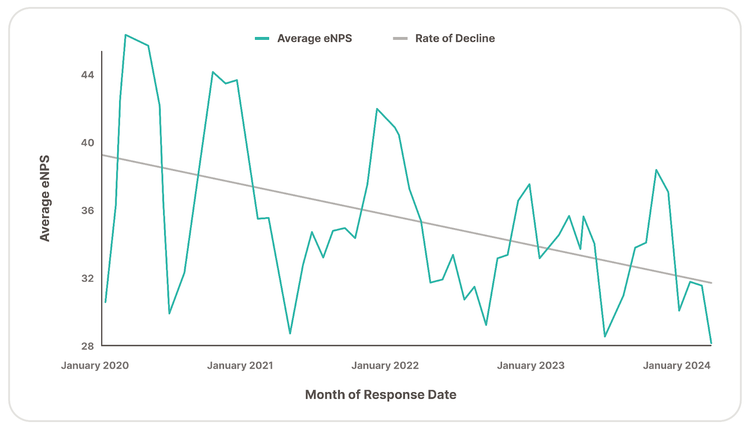
- Q3 eNPS dropped to 33 from 36 in Q2, reaching a four-year low.
- There was a 9% decrease from Q2 to Q3.
- eNPS is 4 points lower compared to September last year—a 12% decrease.
The nonprofit sector faced challenges in Q3 2024, with a significant drop in eNPS to 33, marking a four-year low. The 9% decrease from Q2 to Q3 and the 4-point decline compared to September last year highlights ongoing struggles in maintaining employee satisfaction. This downward trend indicates a need for strategic interventions to address employee engagement and morale within the sector.
"The only thing that’s going well in the industry is we’re getting more clients and working harder. But employees need to be considered assets, not tools, which is not often the case.”
Senior IT Specialist | Educational Nonprofit
From Data to Action: HR Best Practices from Q3 2024 eNPS Insights
By understanding these trends and implementing targeted strategies, HR professionals can improve employee satisfaction and drive organizational success. Here are seven key takeaways from Q3’s report:
- Leverage Tenure for Satisfaction: Recognize the value of tenured employees by implementing retention strategies that enhance their experience, such as career development programs and recognition initiatives.
- Tailor Strategies to Industry Trends: Acknowledge the unique challenges and strengths of your particular industry. For example, while the travel and hospitality industry is thriving, nonprofits face challenges. HR should customize their strategies to address these specific industry needs.
- Adopt Best Practices from Larger Companies: Smaller companies can benefit from adopting structured feedback mechanisms and comprehensive employee support systems that have proven successful in larger organizations.
- Consider Regional Cultural Factors: Recognize regional differences in eNPS and tailor engagement strategies to align with cultural factors, ensuring a more inclusive and effective approach.
- Sustain Recovery in Key Industries: For recovering industries like technology and education, focus on maintaining momentum by continuously monitoring feedback and adapting strategies to sustain positive trends.
- Investigate and Address Declines: For industries experiencing declines, such as nonprofits, conduct thorough investigations to understand the root causes and implement targeted interventions to reverse negative trends.
- Emphasize Continuous Monitoring and Adaptation: Regularly update and analyze eNPS data to stay informed about employee sentiment, allowing for timely adjustments to policies and practices.
About BambooHR
BambooHR® is the leading HR software solution that sets people free to do great work, by managing the complex work of supporting employees and succeeding as a business, while giving leaders all the data they need to make informed strategic decisions.
Intuitively designed and easy-to-use benefits administration, payroll, performance, time tracking, and reporting where everything works together means less focus on process and more focus on growing what matters most—people.
Over the past 15 years, BambooHR has been the trusted partner of HR professionals at 33 thousand companies with employees in over 190 countries and 50 industries, supporting millions of users throughout their employee experience.
Methodology
All source data is from BambooHR® Employee Satisfaction, gathered between January 2020 and September 2024, and includes more than 1,700 companies, tracking anonymized responses from over 60,900 unique employees since January 2020. Data analyzed includes more than 2.22 million self-reported eNPS scores. The most recent quarter’s data is added to the historical data set on the first day of the new quarter.
Industries included are healthcare, finance, construction, travel and hospitality, nonprofit, restaurant, food, and beverage, education, and technology.
Further demographics included are company region, company headcount, and average employee tenure at a company.
Looking for More HR Data Insights? Keep Reading
BambooHR Workforce Insights
Read the latest report to see how hiring, job openings, turnover, review, and PTO trends are changing every month.
Compensation Trends for 2024: Deflation, Transparency, and Benefits
24% of workers say they’d be willing to take a salary cut if it meant job security for the next year. Read the report to understand how workers are feeling and why.
The New Surveillance Era: Visibility Beats Productivity for RTO & Remote
What exactly is the Green Status Effect and who is more productive, remote or in-office workers? Check out the 2024 report to find out.